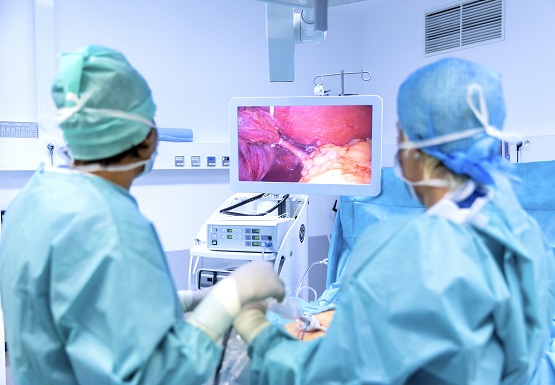
Also known as ‘keyhole surgery’ or simply laparoscopy, laparoscopic surgery requires smaller incisions than traditional open surgery and is performed with smaller instruments. Dr Wong Soong Kuan, Consultant General Surgeon at The Colorectal Clinic Pte Ltd, explains its advantages and limitations.
LAPAROSCOPIC VS. TRADITIONAL SURGERY
Laparoscopic surgery is a minimally invasive surgical method used to access the interior of the body through a small incision, removing the need for open surgery. In order to create space within the confines of the abdominal cavity, a ‘pneumoperitoneum’ is created by pumping carbon dioxide into the abdominal cavity to create a spatial dome.
In laparoscopic surgery, ports or small tubes measuring 5 to 12mm are placed in the abdomen to allow a camera system and long slim pencil-like instruments to be inserted and used.
A laparoscopic surgeon needs to be proficient in open surgery and must have performed a sufficient number of complicated laparoscopic operations in simulated scenarios during surgical training. A growing number of surgeons are pursuing sub-specialties in different types of laparoscopic surgery.
THE BIG ADVANTAGE OF SMALLER ACCESS
Essentially, traditional surgery involves maximal access whereas laparoscopic surgery aims for minimal access.
“With traditional open surgery, the wounds are significantly larger than with laparoscopic surgery,” explained Dr Wong. “Consequently, there is usually more postoperative pain and the recovery process is correspondingly lengthened. In particular, the return of bowel function is longer with open surgery. There are also more opportunities for wound issues like infection to occur because of the larger wound.”
For obvious reasons, the scarring is greatly reduced with laparoscopic surgery compared to traditional open surgery. Many laparoscopic procedures leave barely visible scars or none at all.
SUITABLE FOR A WIDE RANGE OF PROCEDURES
Laparoscopic surgical techniques are generally recommended for the following procedures:
• Gallbladder removal
• Appendectomy
• Hernia repair
• Gynaecological procedures such as ovarian cyst rupture, uterus removal
• Urological procedures such as kidney and prostate surgery
• Colon and rectal tumour surgery
• Bariatric surgery for obesity
• Fundoplication surgery for oesophageal reflux disease
• Reconstructive surgery for pelvic floor prolapse
• Liver and bile duct surgery in selected situations
• Adrenal tumour removal
EXCLUSIONS AND LIMITATIONS
“An important point to note is that not all types of surgery can use laparoscopic techniques,” highlighted Dr Wong. “Typically, if the tumour is large, the patient is too ill or has internal adhesions from a previous open surgery, it may be necessary to go for open surgery.”
Laparoscopic surgery also requires a clear view from the camera. If there are dense adhesions between intestinal loops, the patient is too ill to tolerate the pneumoperitoneum pressures, or there is bowel distension of bleeding that obscures the visual in the camera screen, then laparoscopic surgery will be difficult.
In addition, very gross enlargement of organs caused by diseases like cancer may make it difficult to perform laparoscopy. Complicated surgeries, where there are many adjacent organs and blood vessels necessitating very precise control in order to isolate and access the targeted tumour or tissue, are generally not suited to laparoscopic techniques. These include pancreatic, liver and bile duct surgeries.
ROBOTIC-ASSISTED LAPAROSCOPIC SURGERY
Robotic-assisted laparoscopic surgery is a refinement of the laparoscopic technique. It allows increased dexterity and work in very small spaces because of additional degrees of freedom, which mimic the movement of the human wrist and allow more precise dissection and even suturing. An extremely high degree of precision is achieved with the aid of robotic arms and servomechanisms, or servos. Servos are devices that provide error-sensing negative feedback to correct the action of a mechanism.
In robotic-assisted laparoscopic surgery, the surgeon has to insert the ports in the abdomen as he would for regular laparoscopic surgery, but thereafter works through a machine interface to control robotic arms that perform the operation.
Robotic-assisted laparoscopic surgery is generally more expensive than regular laparoscopic surgery, as the robotic machine and related consumables are relatively costly.
WHEN ROBOTIC-ASSISTED HAS THE EDGE
Operative situations in which robotic assisted laparoscopic surgery offers a clear advantage over regular laparoscopic techniques currently include prostate surgery, where there is a need to suture a water tight joint between bladder and urethra, as well as certain advanced urological procedures. In addition, it is often the preferred technique for very low-lying rectal cancers.
ON THE HORIZON
No doubt robotic-assisted laparoscopic surgery will continue to advance in tandem with ongoing improvements in miniaturisation that will result in increasingly smaller machines. Currently, robotic consoles can occupy considerable space in the operating theatre.
The development of better instrumentation and devices for dissection and the stemming of bleeding will also help laparoscopic surgery to progress. Likewise, video advancements in 3D and virtual reality will allow better spatial orientation and overcome the limitations of situational awareness with current platforms. Computer simulation prior to surgery will also help the surgeon prepare better prior to surgery and avoid unplanned scenarios.
Without a doubt, laparoscopic surgery is here to stay. And the ‘smaller’ it gets, the bigger the benefits for patients.
Article contributed by Dr Wong Soong Kuan, accredited doctor from Mount Alvernia Hospital.
This article is taken from our MyAlvernia Magazine Issue #38. Click here to read the issue on our website or on Magzter.